In my work as a teacher and reading specialist, I have found time and time again that children who struggle with reading often struggle with phonological awareness, too.
And that makes sense, right? If you have trouble hearing the sounds in words, it’s going to be harder to put sounds together when you’re decoding. It’s also going to be harder to spell words if you can’t clearly hear their sounds.
For this reason, I always assess my struggling readers’ phonological awareness. Based upon the results, I incorporate quick phonological awareness activities into their intervention routine. I’ve seen very positive results from doing so!
In today’s post, I’ll describe the different phonological awareness skills I teach, as well as provide free phonological awareness interventions to help your students improve in each area.
And although today’s post is part of my series on supporting struggling decoders, the ideas and materials are appropriate for most students in the primary grades. The vast majority of early readers benefit from phonological awareness instruction.
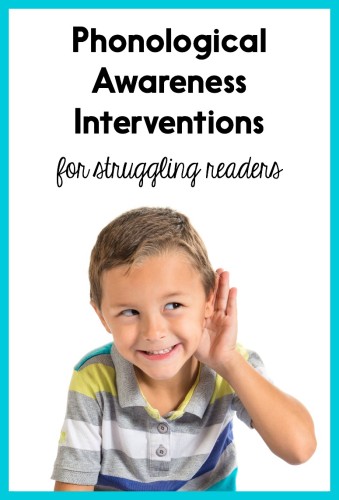
What Is Phonological Awareness?
Phonological awareness is, simply, the awareness of the sounds that make up spoken language. It doesn’t involve alphabet letters (connecting sounds to print is phonics).
An example of a phonological awareness activity would be a teacher saying a word aloud and students saying each individual sound in the word. An example of a phonics activity would be a teacher writing a word on the board and having students say each individual sound in the word while looking at the letters.
It’s beneficial (for K-1 teachers) to spend a 10-15 minutes each day teaching phonological awareness by itself (with no letters or print involved).
At the same time, phonological awareness skills can develop through work with actual print. For example, when children segment words and write their sounds, this helps them practice the phonological awareness skill of segmenting (even though it is technically a phonics-based activity).
Furthermore, it’s important for us to help students understand the connection between phonological awareness activities and reading/writing. Saying things like, “You know how we practice saying each sound in a word? That helps us figure out how to spell words” can help them see the connection.
To summarize: phonological awareness does not involve print (alphabet letters or words), and beginning readers should have opportunities to practice working with sounds (without connecting them to letters). At the same time, phonological awareness can be developed through activities involving print, and students need to understand the connection between hearing sounds in words, reading, and writing.
One other note: You’ve probably also heard the term “phonemic awareness.” Phonemic awareness is a subset of phonological awareness – it describes one set of skills that falls under the larger category of phonological awareness. I’ll define phonemic awareness and provide teaching activities later on in this post.
What Phonological Awareness Skills Should Students Learn?
Children’s phonological awareness skills typically develop along this continuum (adapted from Chard and Dickson’s article “Phonological Awareness: Instructional and Assessment Guidelines”):
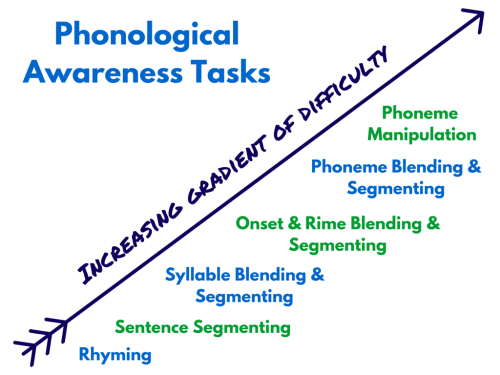
See the original image at http://www.ldonline.org/article/6254/
Not all children develop in the same way, of course. But kids are typically going to learn to identify rhymes before, say, they can segment the individual sounds in words.
Assessment can help you determine where students are “at” along this continuum, and what they need to work on. I don’t recommend administering lengthy phonemic awareness assessments to all your students multiple times a year. However, if you notice that certain students are struggling with either phonological awareness or decoding, you may want to spend a little time figuring out what they need to work on.
A phonological awareness assessment can be very quick and simple. If you use my phonics program, From Sounds to Spelling, you already have phonological awareness assessments (and lessons) built into the program. If you’d like to learn more about From Sounds to Spelling, you can do so at this link.
Reading Rockets also has some general guidelines for creating your own assessment here. An assessment can be as simple as asking a child to identify pictures of rhyming words, generate a word that rhymes, count the number of words in a sentence, count the number of syllables in a word, say the first sound in a few different words, and/or verbally segment a couple of CVC words.
What Should We Do When Students Struggle with Phonological Awareness?
If our assessment results (and observations) indicate that certain students struggle with phonological awareness, we can take specific steps to help them improve.
First of all, we can plan daily practice activities to develop phonological awareness. Research shows that students who struggle with phonological awareness benefit from practicing these skills in a small group setting. However, that doesn’t mean that you have to eliminate whole-class phonological awareness instruction.
During my one-on-one or small group phonological awareness activities, I like to have students close their eyes sometimes. This helps them focus on just listening. We show students so many visuals throughout the day that it can be a bit confusing for them when we just want them to listen!
I’ve also found that hands-on activities can be helpful for struggling students. These same students sometimes have attention issues and can quickly get bored with activities that involve only listening to or speaking sounds. The rest of this post will focus on specific, mostly hands-on activities that you can use to teach phonological awareness. To receive all of the activities and materials (for free!), sign up here:
Rhyming Activities
Rhyming is one of the most basic components of phonological awareness. Using nursery rhymes, poetry, and songs in the classroom (including in a small group setting) is helpful in helping children hear and identify words that rhyme.
When you work with a nursery rhyme, poem, or song, model how to listen for and find words that rhyme. You can say something like this: “Words that rhyme sound the same at the end, like mug and bug. While I read this poem to you, I’m going to listen for words that rhyme.” As you go through the text, stop when you hear words that rhyme and point them out to the children. The kids will soon be able to join in and find words that rhyme!
As children’s rhyming abilities improve, you can have them clap or raise their hands when they hear a pair of words that rhyme. You can also begin asking them to generate their own rhyming words (“What rhymes with ___?”). To connect rhyming words to print, use a highlighter to show students how rhyming words often have the same endings (i.e. the words mug and bug in the example above both end with “ug.”
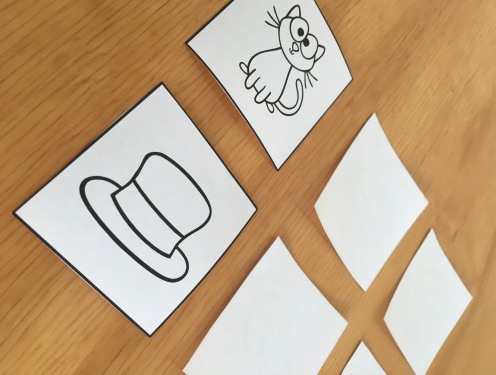
For some hands-on rhyming fun, try playing Rhyming Words Memory. First, have students practice making matches with the cards turned face-up. Then, turn them all face-down and mix them up. Students take turns trying to find pairs of pictures that represent rhyming words. Make sure that students name each picture aloud when they turn it over!
Rhyming word picture sorts are another fun activity. Divide a piece of paper into two columns, and draw or place a word at the top of each column (like “dog” and “pen”). Have students sort additional pictures into the columns, depending upon what each word rhymes with. For a challenge, students can also draw their own pictures to add to each column.
All of these activities are appropriate for your entire class, as well as for students who struggle with phonological awareness. Struggling students will benefit most, however, from participating in these activities in a small group setting.
Sentence Segmenting
Sentence segmenting is the next skill shown on the continuum. This is the ability to hear the individual words in sentences. Although sentence segmenting is quite simple for adults, it can be very challenging for children. Becauseinrealitywetalklikethis, not……..like…….this. Because our spoken words flow together, it’s not easy for little ones to distinguish one word from the next!
I try to integrate sentence segmenting throughout the day, especially when I’m modeling writing. When I want to write a sentence, I say it aloud to students, modeling how I count each word on my fingers. Then, we say the sentence together, and the kids count the words on their fingers. Next, I show them how I draw a line for each word. This drives home the point that sentences are composed of individual words, and we have to listen carefully to hear them.
In addition to this daily practice, struggling students also benefit from sentence segmenting practice in a one-on-one or small group setting. Practice can be simple – just say a sentence aloud and have students count each word on their fingers. You can also use counters and a grid to have students push one counter into a square for each word they hear:

As with all of the materials pictured in this post, you can get this resource by signing up here (you only need to sign up once to receive all of these materials in one download):
Sentence segmenting helps with key emergent reading and writing skills, like pointing one-to-one and spacing between words. Explicitly point out the connection between any sentence segmenting activities you do and the literacy activities that they support.
Syllable Blending and Segmenting
Next up is syllable blending and segmenting! I always start with blending, or having students put together syllables to form a complete word, because I feel that it’s a bit easier for students to master. To practice blending, say the syllables in a word aloud (cat…er…pil…lar) and then have students pronounce the complete word correctly. You can mix things up by showing students a picture, saying the syllables aloud to name something in the picture (“Do you see the el…e…phant?”), and then having students say the word and point it out in the picture.
To practice segmenting (breaking words up into their syllables), students can jump, clap, or tap for each syllable they hear in a word you say aloud.
You can also try a syllable picture sort. Have students each picture aloud, count the number of syllables in the word, and then sort the picture:

Helping children understand that a word can have multiple syllables is vital in getting students to point one-to-one when reading. You might see some students pointing multiple times when they are “reading” a multisyllabic word, because they think that 1 syllable = 1 printed word. Help them see the connection between the syllable segmentation activities and their pointing during reading (“Do you remember that we found out that some words have a couple of syllables? Even if a word has several syllables, like computer, we only point to that word once because it’s still just one word.”)
Onset-Rime Blending and Segmenting
Onset-rime blending involves being able to say the complete word when the first chunk (onset) and the vowel + the rest of the word (rime) are broken apart. For example, if you say “r-oad” and the child can say “road,” that child can blend an onset and rime.
To practice onset-rime blending, have students practice this skill for just a minute or so per day – it’s a great way to transition to activities.
You can also gather struggling students in a small group, show them a picture, and ask them to find certain objects (“Can you find a c-up?”or “Can you find the th-umb?”).
Onset-rime segmenting is the opposite: students are the ones who have to break up a word into its onset and rime (taking gum and turning it into g-um, for example). After you’ve practiced this skill as a class, you can have students break up into pairs (or work with you in a small group) to play my Onset & Rime Mystery Word Game (included in your download).
To play the game, give pairs of students a stack of picture cards. They should keep the picture cards between them, face-down. One student takes the top card, secretly looks at the picture, and says the onset and rime. The second student has to say what the complete word is. Students then reverse roles for the next picture.
Again, you can sign up to receive all these materials here:
Phoneme Blending and Segmenting
Next on the continuum is phoneme blending and segmenting! Phonemes are the smallest sounds in spoken language, like the sound /t/ or /ch/. Phonemic awareness is the awareness of those individual sounds.
Phoneme blending is the ability to put together individual sounds to make a word (knowing that /s/ /i/ /t/ makes the word “sit”).
You can play “guess the word” for a minute or two each day by breaking up a word into its individual sounds and then having the children say the complete word. Check out this not-fancy video of me demonstrating two different possible ways to incorporate movement into phoneme blending (they can also be used for working on phoneme segmentation):
To have students practice phoneme blending in a small group, print out a variety of pictures and spread them out on the table. Say the sounds in one of the words, and then have students all point to the picture. (This is best done in a very small group of 2-3 students to avoid some students simply following the lead of the others.)
Phoneme segmenting is a bit trickier. It requires students to be able to break apart a word into its individual sounds (i.e. turning “top” into /t/ /o/ /p/.
In addition to daily oral practice, Elkonin boxes are another great way to practice phoneme segmenting. Give students a small grid with 3 or 4 boxes (depending upon what type of words you are working on). Have them touch one box or push a counter into a box for each sound that they hear in a word.
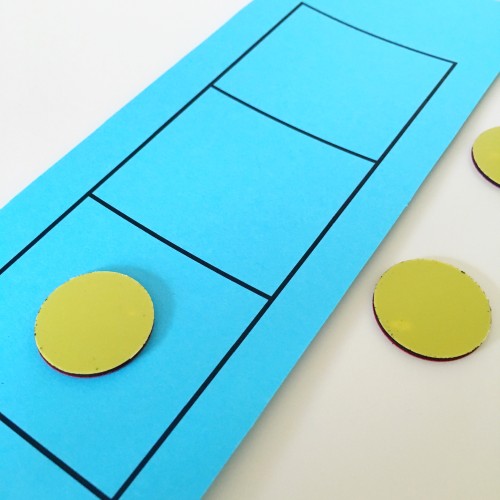
I recommend using Elkonin boxes in a one-on-one or small group setting so you can closely monitor how students are doing.
Phoneme Identification and Manipulation
Last but not least, we have phoneme identification and manipulation! When I say “phoneme identification,” I mean the ability to identify whether a sound in a word comes first, in the middle, or last. This skill is helpful in teaching students to write words phonetically. You can have students practice with the Elkonin boxes featured above (“Say each sound in the word hop. Now touch the box that shows where the sound /p/ comes.”)
Phoneme manipulation is the ability to add, remove, and substitute phonemes in words. Here are some examples (say the words out loud if you are confused by any of these!):
- Phoneme Addition: “If I add /t/ to the end of go, what do I get?” (goat)
- Phoneme Deletion: “If I take away the /c/ sound in cat, what word do I have?” (at)
- Phoneme Substitution: “Say the word hop. If I say /t/ instead of /p/, what do I get?” (hot)
Phoneme manipulation can be fun, playful, and helpful in getting kids more skilled in working with words. It may also be difficult at first, but research shows that it can further develop as kids learn to read.
Conclusions
To best support your struggling readers with phonological awareness skills, remember the following:
- Many, but not all, struggling readers have poor phonological awareness
- Instruction should be brief – the majority of your instructional time should be spent on phonics
- Phonological awareness skills will develop over time and may take lots of practice for some children
What Causes Decoding Difficulties in Beginning Readers, and What Can Teachers Do About It?
How To Analyze Running Records (And Get a Ton of Valuable Information About Your Beginning Readers!)
How to Teach Decoding Strategies to Struggling Readers
Phonics Interventions for Struggling Readers in K-2
How To Give Struggling Readers More Practice Time Through Volume Reading
Resources
Chard, D. J., & Dickson, S. V. (1999). Phonological awareness instructional and assessment guidelines. Intervention in School and Clinic, 34(5), 261-270.
National Institute of Child Health and Human Development. 2000. Report of the National Reading Panel: Teaching Children to Read: An Evidence-based Assessment of the Scientific Research Literature on Reading and Its Implications for Reading Instruction: Reports of the Subgroups. Washington, D.C.: U.S. Department of Health and Human Services, NIH Pub. No 00-4754.
*The authors of these texts are in no way affiliated with this blog – I am referencing their work as a means of explaining and supporting the ideas I set forth in this post.*


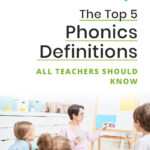
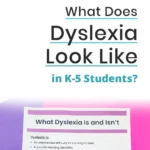


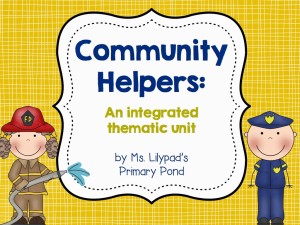






Hello,
Is there any way i can have this article emailed to me?
Kind regards,
Ashley
Hi Ashley, were you looking for the article itself, or the free downloads? The free downloads will be automatically emailed to you when you put your email address in one of the boxes within the text. 🙂 Alison
I would also like this article as a download. I have entered my email to receive the downloads, but I would love to share this information with my K & 1 teachers. Thank you for the information.
Hi Carolyn! Please do feel free to share with your K-1 teachers! You can copy and paste the text or just print the actual page. I can be cited as follows: Ryan, A.L. (2016, January 23). Phonological awareness interventions for struggling readers [Web log post]. Retrieved from https://learningattheprimarypond.com/blog/phonological-awareness-interventions-for-struggling-readers/ I also do have an ebook with all the information from the series in one place. You can access that here: https://www.teacherspayteachers.com/Product/How-to-Support-Primary-Readers-Who-Struggle-with-Decoding-An-E-Book-2357218 I hope that helps! Let me know if you have any questions. Alison
I work with ESL students and these are great strategies I will work to implement with many of them!
Hi Anne! So glad they are helpful! Let me know how it goes!! Alison
Loving this information all in one place, and FREE! Thank you! I’m a kindergarten instructional coach aND this year it seems that we have a large number of our struggling students who cannot produce rhymes. Some can recognize rhymes and some can’t. We have been intervening with these students for 18 weeks, now they have also attended tutoring 5 weeks. Most have been able to move up the phonological continuum but cannot get that rhyming! Why?
Hi there! That’s so odd that they can do the more difficult tasks but not the rhyming! I wonder if it has anything to do with the way our culture has sort of evolved over time – I know that when I was young, my mom would read and sing nursery rhymes with me. Today, that doesn’t happen for many of our students. Are your students English language learners? That might have something to do with it, too. Otherwise, I’d say just keep on truckin’ and as long as they are getting other skills, maybe the rhyming will come in… Read more »
This is such a wonderful explanation! I’m embarrassed to say that I have a master’s degree in teaching, and I did not know the difference between phonics and phonological awareness. Thank you!
I’m so glad it was helpful, Jenny! I had an undergrad professor who really emphasized the difference, and I guess I never forgot it! 🙂
Alison
Hi!Alison..thank you so much..this would be a big help for me & to my pupils.
Hi
Thinks for any thinks
⚘⚘🌷🌷🌷🌺🌺🌺
hello, love this site! I have been using the strategy chart. I say point to the strategy you need to use.
Now I need the alphabet chart for my little ones. I can’t find it. Can you help?
Many Thanks1
Hey Rebecca! I have an alphabet chart in a free download here: learningattheprimarypond.com/free
I hope this helps!
Alison
I can’t wait to try these strategies with my student, he struggles a lot with decoding words and writing. Thanks!
Thank you for sharing tis important information. Another thing for instructors to keep in mind when segmenting is to model going from OUR right to OUR left so that students see it from THEIR left to THEIR right. It’s tricky and takes some practice on our part, but it’s important so they’re not confused.
You’re so welcome! 🙂 Yes, I agree that modeling from the students’ perspective is important as well! Thank you for sharing!
I like this piece.Please, i need some of your phonological awareness materials. Thanks
Dear Alison,
I have just discovered your posts, and I love them. I have recently started teaching native Spanish speakers how to read. I would love any materials you can share. I see you have quite a bit on TPT. I’m hoping to get approval for some purchases from my Ed. Coordinator.
Thanks for all of this great info!
Hi Colleen! So glad you are enjoying the posts! Yes, I have a ton on TpT for Spanish resources! These are my Differentiated Writing Prompts in Spanish and here are Writing Bundles in Spanish. Best of luck!!
Absolutely fantastic reading. Grateful for your work and making this intervention method accessible.
Thanks for your kind words, Kim!
I teach English Learners. Should I use all of these activities, even when they don’t know what the words mean?
Hey Teri! Great question. With ELL, I recommend providing a quick definition of what a word is and allowing them time to put that word into context. Here’s another blog I wrote that might help: https://learningattheprimarypond.com/blog/how-to-teach-sight-words/